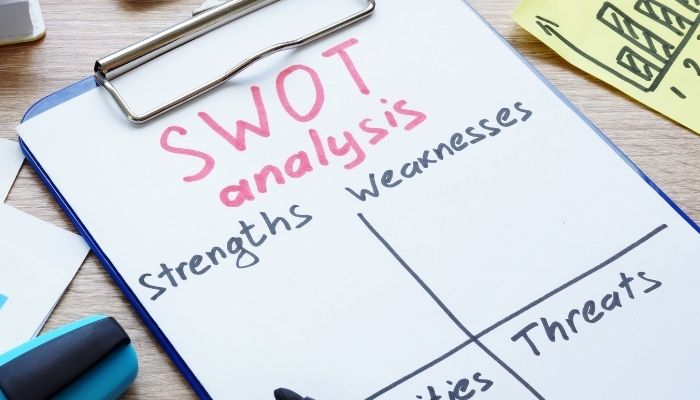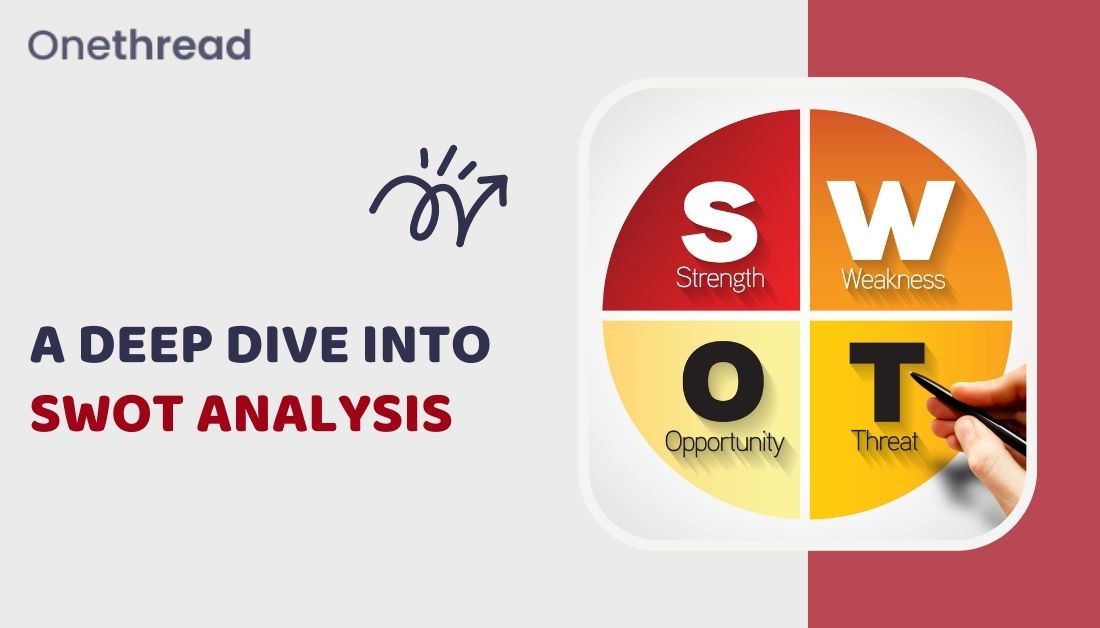The business world is a sea teeming with immense potential and dangerous pitfalls. To navigate the business world, you need a reliable compass to highlight your strengths and pinpoint areas requiring attention. SWOT Analysis. helps organizations unlock their true potential by identifying their Strengths, Weaknesses, Opportunities, and Threats.
Introduction to SWOT Analysis

Defining SWOT Analysis: The Basics and Beyond
SWOT Analysis, which stands for Strengths, Weaknesses, Opportunities, and Threats, is a practical, easy-to-use tool that helps businesses understand their current situation and make informed decisions. Its simplicity, universality, and effectiveness make it a go-to resource for organizations of all types and sizes.
Why SWOT Analysis is Essential for Business Strategy
SWOT Analysis is fundamental for business strategy because it provides a clear and concise overview of an organization’s internal and external environments. This enables businesses to exploit their strengths, remedy weaknesses, grasp opportunities, and mitigate threats. As such, it is critical in strategic planning and business decision-making.
The Fundamentals of SWOT Analysis
The Four Pillars of SWOT Analysis

The SWOT Analysis stands on four pillars: Strengths, Weaknesses, Opportunities, and Threats. Strengths and Weaknesses are internal factors primarily within an organization’s control. Opportunities and Threats, on the other hand, are external factors that arise from the broader market or industry environment.
Strengths: Identifying Your Competitive Advantage
Strengths are the positive internal factors that give an organization its competitive edge. These can include its resources, capabilities, or competitive advantages. For instance, a company might possess a powerful brand, a robust customer base, or a highly skilled workforce.
Weaknesses: Recognizing Areas for Improvement
Contrastingly, weaknesses are the negative internal factors that could impede a company’s success. These involve limited financial resources, ineffective management structures, or lackluster products or services. Acknowledging these weaknesses is the first step towards overcoming them.
Opportunities: Spotting Potential for Growth
Opportunities are favorable external factors a business can exploit to boost its growth. For example, changes in the market, the advent of new technologies, or the emergence of recent consumer trends can all create opportunities.
Threats: Uncovering Potential Risks
Threats are unfavorable external factors that threaten a company’s growth or survival. These could include changes in the economic landscape, actions of competitors, or introducing new regulations. Recognizing threats early can help organizations devise effective strategies to mitigate their impact.
How to Conduct a SWOT Analysis: A Step-by-Step Guide
Conducting a SWOT Analysis is about more than just understanding the tool’s essential components. Instead, it involves a step-by-step process, from defining the objective to formulating a strategic plan.

Step 1: Determining Your Objective
The first step in conducting a SWOT Analysis is to define your objective. This could be as broad as devising a new business strategy or as specific as launching a new product. Having a clear goal gives your SWOT Analysis direction and purpose.
Step 2: Gathering Relevant Information
Next, you must gather all relevant information about your organization and its environment. This includes understanding your organization’s resources and capabilities and external factors like market trends and competitor actions.
Step 3: Brainstorming and Compiling Ideas
The third step involves brainstorming and listing your organization’s strengths, weaknesses, opportunities, and threats. Again, this should involve critical organizational stakeholders to ensure a comprehensive and accurate analysis.
Step 4: Analyzing and Refining Findings
Once you’ve compiled your list, the next step is to analyze and refine your findings. You should rank each factor according to its importance and impact on your objective. This will help you identify key strengths to leverage, critical weaknesses to address, major opportunities to seize, and significant threats to mitigate.
Step 5: Developing a Strategy Based on SWOT Analysis
Finally, you should use the insights gained from your SWOT Analysis to develop a strategic plan. This should involve strategies for leveraging strengths, addressing weaknesses, seizing opportunities, and mitigating threats.
Tools for Effective SWOT Analysis

A SWOT Analysis can be made more accessible with the right tools and resources. Here are a couple that you might find helpful.
SWOT Analysis Template: Simplifying the Process
A SWOT Analysis template can help streamline the process. It provides a clear, organized structure for your analysis, enabling you to easily input and visualize your strengths, weaknesses, opportunities, and threats.
Making Use of SWOT Analysis Examples: Learning from Others
Looking at examples of SWOT Analysis can also be valuable. They can give you insights into how other organizations have conducted their analyses, what they’ve identified as their SWOT factors, and how they’ve used these insights to formulate strategies.
The Importance of SWOT Analysis in Strategic Planning
SWOT Analysis is more than just a theoretical tool; it is crucial in strategic planning and decision-making.
Using SWOT Analysis for Informed Decision-Making
SWOT Analysis facilitates informed decision-making by providing a comprehensive overview of an organization’s internal and external environments. It enables businesses to make strategic decisions that capitalize on their strengths, address weaknesses, exploit opportunities, and mitigate threats.
Linking SWOT Analysis to Business Goals and KPIs
Furthermore, SWOT Analysis can be linked to business goals and Key Performance Indicators (KPIs). By aligning the findings of a SWOT Analysis with organizational objectives, businesses can ensure that their strategies are focused, relevant, and impactful.
Real-World Applications of SWOT Analysis
SWOT Analysis isn’t just theoretical; it has practical, real-world applications. First, let’s look at a detailed case study.
SWOT Analysis Example: A Detailed Case Study
Consider a small startup looking to launch a new product in the market. Using a SWOT Analysis, they identify their strengths (a unique product, a talented team), weaknesses (limited financial resources, lack of brand recognition), opportunities (a growing market, lack of competition), and threats (potential entry of larger competitors, regulatory changes).
Using these insights, they develop a strategic plan. They leverage their product and talented team to create a strong marketing campaign. Finally, they seek funding to address their financial limitations and build brand recognition.
Common SWOT Analysis Mistakes and How to Avoid Them
While SWOT Analysis is a powerful tool, it’s also susceptible to certain pitfalls. Here are some common mistakes and how you can avoid them.
Overlooking Internal Factors
One common mistake is overlooking internal factors. Many businesses focus heavily on external factors like market trends and competitor actions while neglecting to evaluate their strengths and weaknesses. Maintaining a balanced perspective is crucial, considering both internal and external factors.
Ignoring External Trends and Changes
Conversely, some businesses need to take into account external trends and changes. For example, the business environment is dynamic and constantly changing; failing to consider this can result in outdated and ineffective strategies.
Misinterpreting Opportunities as Strengths and Vice Versa
Another common mistake is misinterpreting opportunities as strengths and vice versa. While there can be overlap, it’s essential to differentiate between the two. Strengths are inherent attributes of your organization, while opportunities are favorable external conditions.
Failing to Use SWOT Analysis Results in Strategy Formation
Finally, some businesses conduct a SWOT Analysis but must incorporate the results into their strategic planning. Remember, a SWOT Analysis is not an end but a means to inform strategy formation.
Advanced Topics Related to SWOT Analysis
Once you’ve mastered the basics of SWOT Analysis, you should delve into more advanced topics.
Comparison of SWOT Analysis and PESTLE Analysis
PESTLE Analysis is another strategic planning tool businesses can use to analyze their external environment. While SWOT Analysis covers internal and external factors, PESTLE Analysis focuses solely on external factors, examining Political, Economic, Sociocultural, Technological, Legal, and Environmental aspects.
The TOWS Matrix: A Different Perspective on SWOT
The TOWS Matrix is an advanced version of SWOT Analysis. However, it goes a step further, looking not just at a company’s SWOT factors but also at how they can be related to each other to formulate strategies.
Personal SWOT Analysis: Applying the Concept to Individual Growth
SWOT Analysis isn’t just for businesses. Individuals can also use it for personal development. A Personal SWOT Analysis can help you identify your strengths and weaknesses, opportunities for growth, and potential personal threats.
Conclusion: Maximizing the Benefits of SWOT Analysis
The world of business is a challenging terrain, but with the right tools, you can navigate it successfully. SWOT Analysis is one such tool, providing you with a clear roadmap to reach your business goals.
Recap: Why SWOT Analysis is a Crucial Business Tool
SWOT Analysis is an essential business tool because it helps you understand your current situation, make informed decisions, and formulate effective strategies. It enables you to leverage your strengths, address your weaknesses, seize opportunities, and mitigate threats.
How to Write a Good SWOT Analysis: Key Takeaways
To conduct a practical SWOT Analysis, remember to define your objective, gather relevant information, brainstorm and compile your SWOT factors, analyze and refine your findings, and develop a strategic plan based on your analysis.
In the dynamic business world, SWOT Analysis is your reliable compass, guiding you toward your strategic goals.
